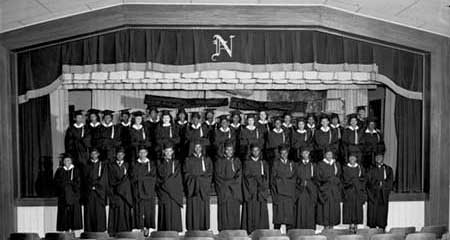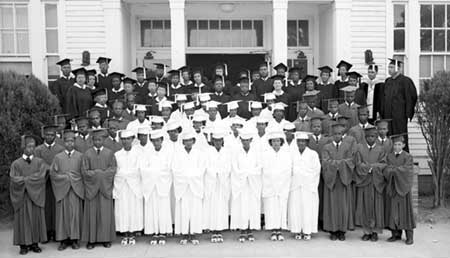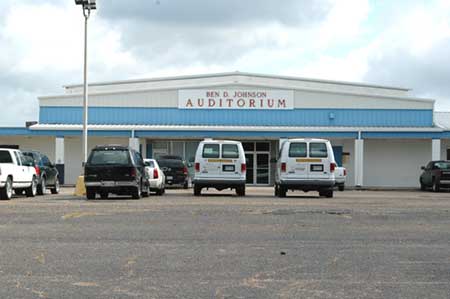Lincoln Institute
Natchitoches Parish Training School/Central High School
Self-Help Shopping Center
Ben Johnson Auditorium
In 1912, Professor J.W. Thomas purchased land for a school for African American children. The following year, a three-room frame building was completed, and the Lincoln Institute opened its doors as a private, all Black school, the first of many educational enterprises that developed at the Sixth Street site.
Lincoln Institute, I don’t know much about the history of Lincoln Institute other than the fact that … several people got together and donated the land and we had a Professor [Thomas] came from Baton Rouge. And he … started the school basically as a teacher and administrator…. These fellas donated the land and raised money and got the land and that was the origin of Lincoln Institute.
In 1919, the Board of Trustees of the Lincoln Institute deeded the property to the Natchitoches Parish School Board, which continued to offer classes there with four teachers until 1925, when a new seven-room structure was constructed with help from the Rosenwald Fund; the number of instructors increased to nine. The new school was named Natchitoches Parish Training School and it offered the first high school classes in that year.
The Training School offered a number of career education classes, among other studies. Alcee Vaughan coached the football team, the basketball team, and other athletics; a marching band was also established. An old theater across from the school was purchased and converted into an industrial workshop for the boys. The 12th grade year at the Training School was considered the first year of college for Louisiana State Negro Normal, now Grambling State University.
Education was one of the priorities of many families here, and after all those graduates and teachers from Southern University came to Natchitoches, all fine areas of learning took place. We had choirs, band, drama teams, physical education, woodwork shops and what have you…. The teachers back when we were coming along had your best interest at heart. They wanted what was best for you. The wanted you to be the best you could be.
In 1938, an elementary school was built on the site with assistance from the Public Works Administration and by the next year 22 teachers were hired to accommodate the growing attendance at the school complex. In 1952, a new brick building for the high school was constructed, and the Natchitoches Parish Training School was renamed Central High School, with F.M. Richardson serving as principal.
I would say they had about nine to ten teachers out there at Natchitoches Central. Some was men and some was women. And I guess each classroom could’ve had eight to ten, maybe twelve children – I would say from 150 to 200 kids out there at that time…. They had two buildings on campus … and the largest one had the chapel in it. You know, where we’d go and attend the chapel services on Fridays. And the principal, he would be the one to lecture or to tell you whatever he needed to pass on. And sometimes they would have a little program or something too. They had a piano and would sing whatever. But it was every Friday, you’d go to chapel.
Attendance continued to grow until a new school was needed. In 1969, the new Central High School building was completed on Gold Street, while the elementary school continued at this site for one more term. After a 1970 court decree, Central High and Natchitoches High were integrated, creating Natchitoches Central High School, marking the beginning of a new era for public education in Natchitoches.
After Central High moved to its new location on Gold Street, the old school complex became the site of the Self-Help Shopping Center, a community-based, minority-owned shopping center that opened in 1973. Some of the shops in the center included the Mid South Citgo service station; the Farmers’ Market grocery store; the Now Shop men’s clothing store; the World of Fashion; and the popular eatery, Clifford Blake’s Drive Inn. The land and former school buildings were purchased by Self-Help Investment, Inc., with a loan from Ben Johnson’s Winnfield Funeral Home. Shares in the corporation were sold to investors, described by Mr. Johnson as “those who need community pride and a feeling of self-reliance and hope that has never been possible before.” By the date of the grand opening, approximately 1,200 people had pledged to purchase over 61,000 shares in Self-Help.
The Self-Help Shopping Center succumbed to the poor economic conditions created by the oil crisis in the 1980s, and the Ben Johnson Auditorium was established at the site. The auditorium today serves as a community center for social events and entertainment.


Graduates, Guillet Collection, #1153, n.d.

Auditorium, Dayna Bowker Lee